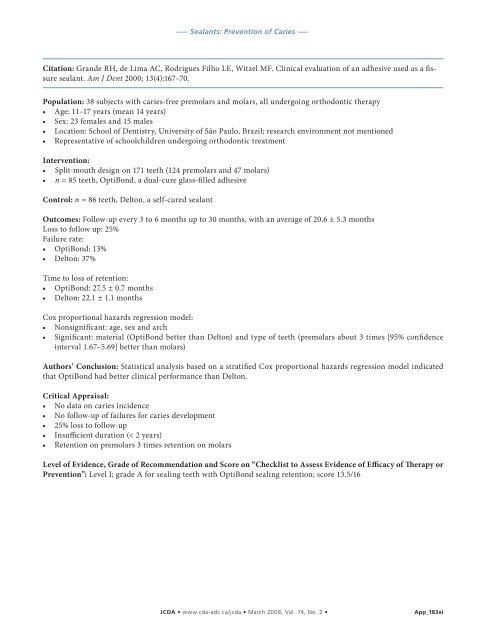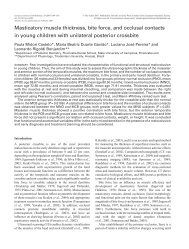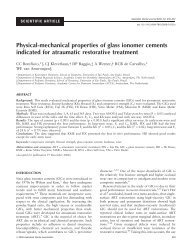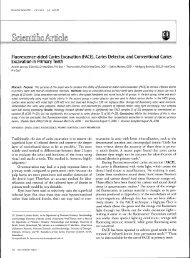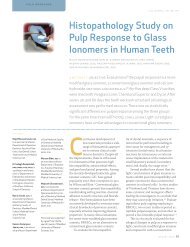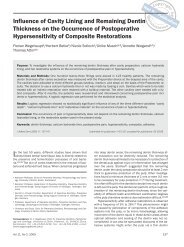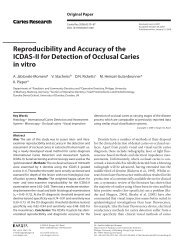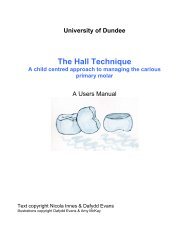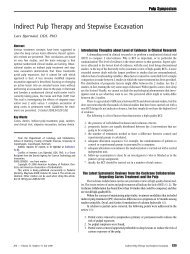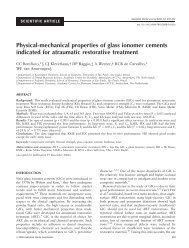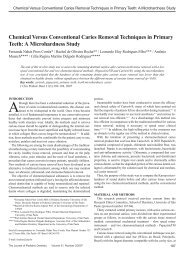Pit and Fissure Sealants in the Prevention of Dental Caries in ...
Pit and Fissure Sealants in the Prevention of Dental Caries in ...
Pit and Fissure Sealants in the Prevention of Dental Caries in ...
Create successful ePaper yourself
Turn your PDF publications into a flip-book with our unique Google optimized e-Paper software.
––– <strong>Sealants</strong>: <strong>Prevention</strong> <strong>of</strong> <strong>Caries</strong> –––<br />
Citation: Gr<strong>and</strong>e RH, de Lima AC, Rodrigues Filho LE, Witzel MF. Cl<strong>in</strong>ical evaluation <strong>of</strong> an adhesive used as a fissure<br />
sealant. Am J Dent 2000; 13(4):167–70.<br />
Population: 38 subjects with caries-free premolars <strong>and</strong> molars, all undergo<strong>in</strong>g orthodontic <strong>the</strong>rapy<br />
• Age: 11–17 years (mean 14 years)<br />
• Sex: 23 females <strong>and</strong> 15 males<br />
• Location: School <strong>of</strong> Dentistry, University <strong>of</strong> São Paulo, Brazil; research environment not mentioned<br />
• Representative <strong>of</strong> schoolchildren undergo<strong>in</strong>g orthodontic treatment<br />
Intervention:<br />
• Split-mouth design on 171 teeth (124 premolars <strong>and</strong> 47 molars)<br />
• n = 85 teeth, OptiBond, a dual-cure glass-filled adhesive<br />
Control: n = 86 teeth, Delton, a self-cured sealant<br />
Outcomes: Follow-up every 3 to 6 months up to 30 months, with an average <strong>of</strong> 20.6 ± 5.3 months<br />
Loss to follow up: 25%<br />
Failure rate:<br />
• OptiBond: 13%<br />
• Delton: 37%<br />
Time to loss <strong>of</strong> retention:<br />
• OptiBond: 27.5 ± 0.7 months<br />
• Delton: 22.1 ± 1.1 months<br />
Cox proportional hazards regression model:<br />
• Nonsignificant: age, sex <strong>and</strong> arch<br />
• Significant: material (OptiBond better than Delton) <strong>and</strong> type <strong>of</strong> teeth (premolars about 3 times [95% confidence<br />
<strong>in</strong>terval 1.67–5.69] better than molars)<br />
Authors’ Conclusion: Statistical analysis based on a stratified Cox proportional hazards regression model <strong>in</strong>dicated<br />
that OptiBond had better cl<strong>in</strong>ical performance than Delton.<br />
Critical Appraisal:<br />
• No data on caries <strong>in</strong>cidence<br />
• No follow-up <strong>of</strong> failures for caries development<br />
• 25% loss to follow-up<br />
• Insufficient duration (< 2 years)<br />
• Retention on premolars 3 times retention on molars<br />
Level <strong>of</strong> Evidence, Grade <strong>of</strong> Recommendation <strong>and</strong> Score on “Checklist to Assess Evidence <strong>of</strong> Efficacy <strong>of</strong> Therapy or<br />
<strong>Prevention</strong>”: Level I; grade A for seal<strong>in</strong>g teeth with OptiBond seal<strong>in</strong>g retention; score 13.5/16<br />
JCDA • www.cda-adc.ca/jcda • March 2008, Vol. 74, No. 2 • App_183xi


